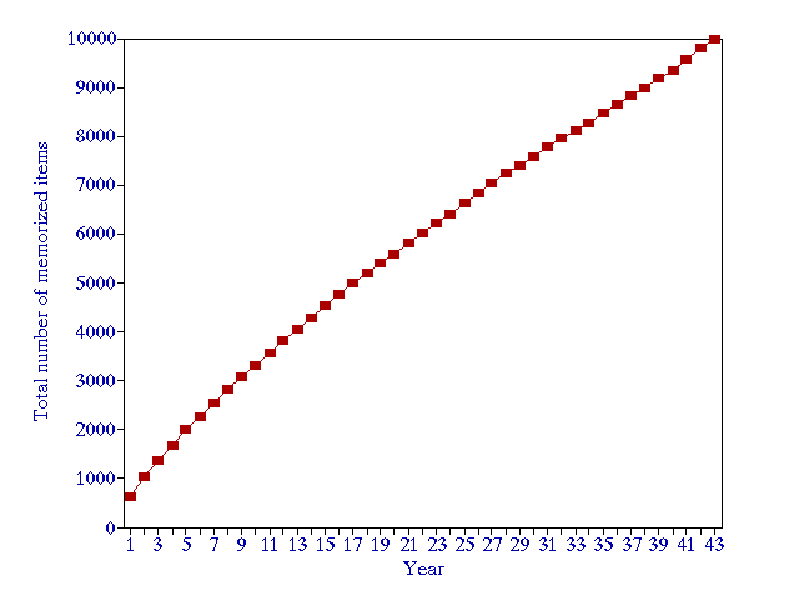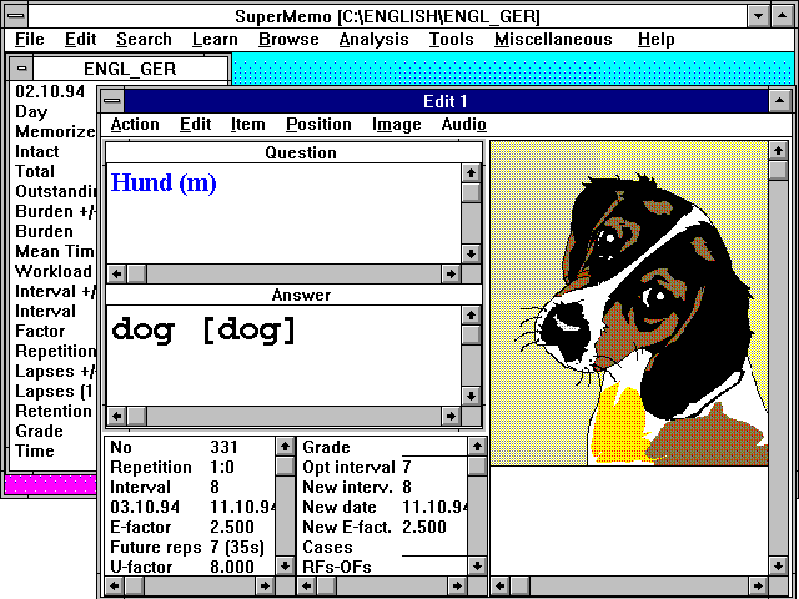SuperMemo is a commercial name of the uniquely Polish technology used in optimizing the process of learning. It can be used to maximize the effects of training in all areas that involve memory. This includes applications such as sciences, technology, languages, touch-typing, playing musical instruments, and many more. SuperMemo employs mathematical techniques to compute the optimum intervals that should separate repetitions in the process of learning. Optimization proceeds by tuning the memory model of an average person to the needs of a particular learner and a particular application. For properly designed applications, the algorithm used in computing the optimum intervals, makes it possible to sustain a constant level of knowledge retention of 95% with 6-10 repetition scheduled in the lifetime. This, for example, makes it possible to master a 40 000 item foreign vocabulary database in a period of 4 years, with the daily working time of 40 minutes
An important characteristic of learning by means of SuperMemo, is that the curve of knowledge acquisition is close to linear in the lifetime perspective, as illustrated in Figure 1 (contrary to popular notions frequently presented in the textbooks on psychology of learning):
Figure 1 Learning curve in the period of 43 years for a typical application of SuperMemo for the daily working time of one minute and retention of 95%. The horizontal axis corresponds to time in years, while the vertical axis presents the total number of individual pieces of information acquired by the learner’s brain (pieces of information are here usually in the form of a single question-answer pair). This figure has been produced by means of computer simulation based on memory models employed in SuperMemo
SuperMemo is the world’s only software with the built-in ability to compute a close-to-optimum spacing of repetitions for a given learner, subject and a given individual item of knowledge. The most advanced flash-card memory-aid systems available in the world do not reach far beyond roughly reducing the frequency of repetitions for the well-remembered material. This unique position of SuperMemo in the memory-aid software category has gained it over 15 000 users in 40 countries of the world (1994). The number of users of SuperMemo shareware reaches far beyond this figure. For example, SuperMemo 5 for DOS is available from all the most popular shareware sites throughout the world. It is also distributed along major shareware CD-ROM titles, including the SimTel DOS Archive
SuperMemo would probably never have reached such a substantial audience, had it not been served as an easy-to-use, user-friendly software available on platforms such as DOS, Windows, Macintosh and Amiga. It is worth noting that SuperMemo has received a number of prestigious software awards in Poland and abroad (including a place in the finals of Software for Europe 1992 at CeBIT, Hanover), which are a testimony of its quality from the software engineering standpoint
The use of SuperMemo is unchangingly simple and consists basically of two activities: (1) creating knowledge databases, and (2) repeating the collected knowledge according to instructions given by SuperMemo. The former step may be skipped if the learner wants to master material that has already been collected in a commercial or shareware database available from database developers.
The learning proceeds along the following cycle in which the user: (1) is prompted with a word, phrase or picture that forms the question, (2) answers the question verbally, using a spelling-pad or recording it with a microphone, (3) accepts a grade determined by himself /herself or by the program. The sequence of repetitions is determined solely by SuperMemo.
The most recent release of SuperMemo for Windows on CD-ROM, includes audiovisual databases for learning languages such as English, Spanish and French. It also includes the audio version of Advanced English, the best-selling database for learning English vocabulary and grammar. The database includes 38,000 entries illustrated with 32 000 recordings of native pronunciation.
The newest version of SuperMemo has been enhanced by new options and features such as: vocabulary lexicon and audio phrase lexicon, full-screen item browsers, subset searching and browsing, dedicated modules for spelling drills, pronunciation drills with a microphone, management of intractable items, integrated database toolkit for database developers, and many more (see Figure 2).
It is important to stress that the Windows release of SuperMemo has been developed with an eye to internationalization. All language dependent modules have been separated from the core code. This makes it possible to develop national versions of SuperMemo within weeks.
Figure 2 One of the most popular application of SuperMemo is learning foreign languages (in the picture: German-English)
The future of SuperMemo seems to lie in its integration with the most recent technologies emerging in the fields of hypermedia and knowledge engineering. The primary goal is to seamlessly merge the currently employed mechanisms with hypermedia authoring tools. This will make it possible to eliminate the unnecessary gap between the retrieval and acquisition of knowledge on one hand, and the process of sustaining the traces of acquired memory on the other [compare: SuperMemo 16]
Independently, no efforts will be spared to move SuperMemo toward open systems with a particular emphasis on multi-platform integration, and object-oriented component programmability of learning modules that determine the scope of SuperMemo’s applicability
About the author:
Piotr Wozniak,
1962, MSc in molecular biology and computer science, President of SuperMemo World, R&D Department, ul. R. Maya
1, 61-371 Poznañ







